Organic social media marketing is a long game. You need to abide by a social media calendar and post consistently, hop on trends, and have a lot of patience before you see tangible results. But what if you want some quick wins under your belt?
Enter: Social media advertising. It’s an arm of social media marketing where you spend money to reach the right audience. It ensures you reach your desired demographics of people instead of relying on social media algorithms.
The problem? Getting started with social media advertising is overwhelming, to say the least. The terminologies are new, the techniques to succeed are different, and the choices are confusing. In this article, you’ll learn everything you need to know to kickstart your social media advertising efforts.
What is social media advertising?
Social media advertising is when you pay to reach your target demographics on any social media platform. It’s a form of digital advertising done on social media. The ad comes up organically in your target audience’s social media feeds as a post or Story. But it has a “sponsored,” “promoted,” “boosted,” or any similar label attached to disclose the post is an ad.
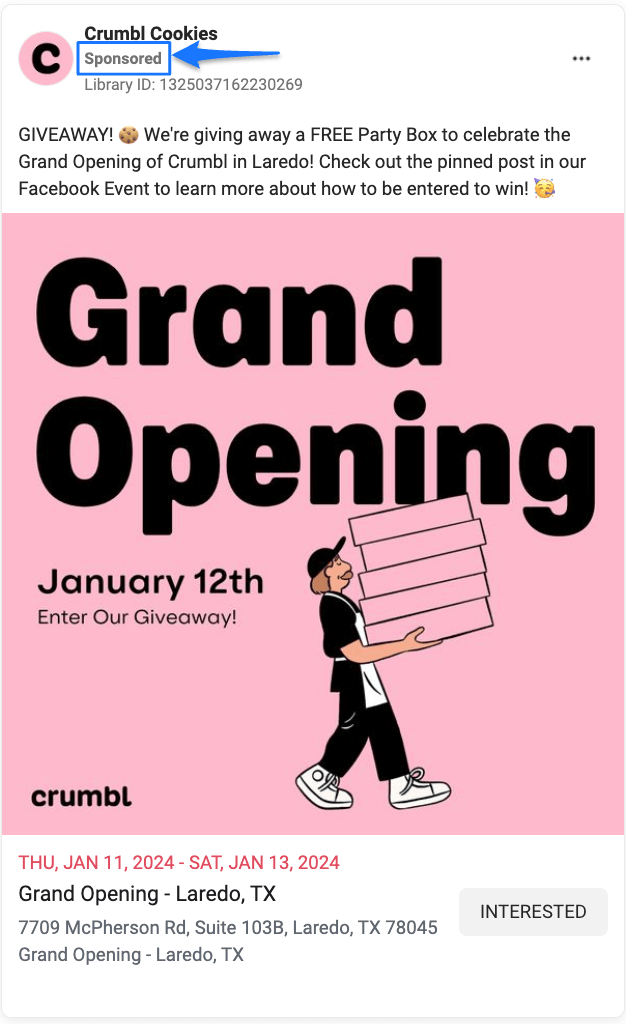
Different social media platforms have different ways and guidelines for displaying your ads. For example, on Instagram, you can show your ads in-feed and on Stories, and you can use images, videos, slideshows, carousels, and polls within your Instagram ads. But on LinkedIn ads, the options differ. There’s text ads, dynamic ads, and sponsored messaging.
There might be some overlap in social media ads on all social media platforms — for example, all channels have image ads. But your messaging and ad creative will differ for each platform depending on the audience demographics on that channel and their purpose for using the social media platform.
For instance, your potential customers might use both Facebook and X (formerly Twitter). But Facebook is used for fun purposes, while X (formerly Twitter) ads should cater more to informative content. Your ad copy and creative will differ depending on your target audience’s preferences.
How does social media advertising fit into social media marketing?
Social media advertising is a part of your social media marketing strategy. How does paid reach differ from organic reach? The former guarantees you reach new customers, while the latter relies on social media algorithms to do the job for you. Since organic marketing is free of cost, getting organic reach on social media depends on consistency, luck, and timing. Comparatively, paid reach is easier because you’re buying some attention from your target audience instead of relying on a mystical and ever-changing algorithm.
That said, social media advertising and organic content work in tandem to create a wholesome social media strategy. Paid efforts ensure you get the bang for your buck, but organic reach is non-negotiable to attract new customers in the long term.
One last thing: Social media advertising is also different from influencer marketing.
- In creator partnerships, influencers create the ad for you and post it from their social media accounts.
- In social media advertising, you create and run ads from your brand account.
You might use influencer-generated or user-generated content within your ads, but the ads are displayed from your own account (except in influencer whitelisting, where you run ads using a creator’s account).
When should you consider running social media ads?
Sometimes, you might think of running social media ads due to situational factors in your business. For example, the telecommunications provider in Switzerland, Swisscom, ran Snapchat ads for launching their new product, “blue.”
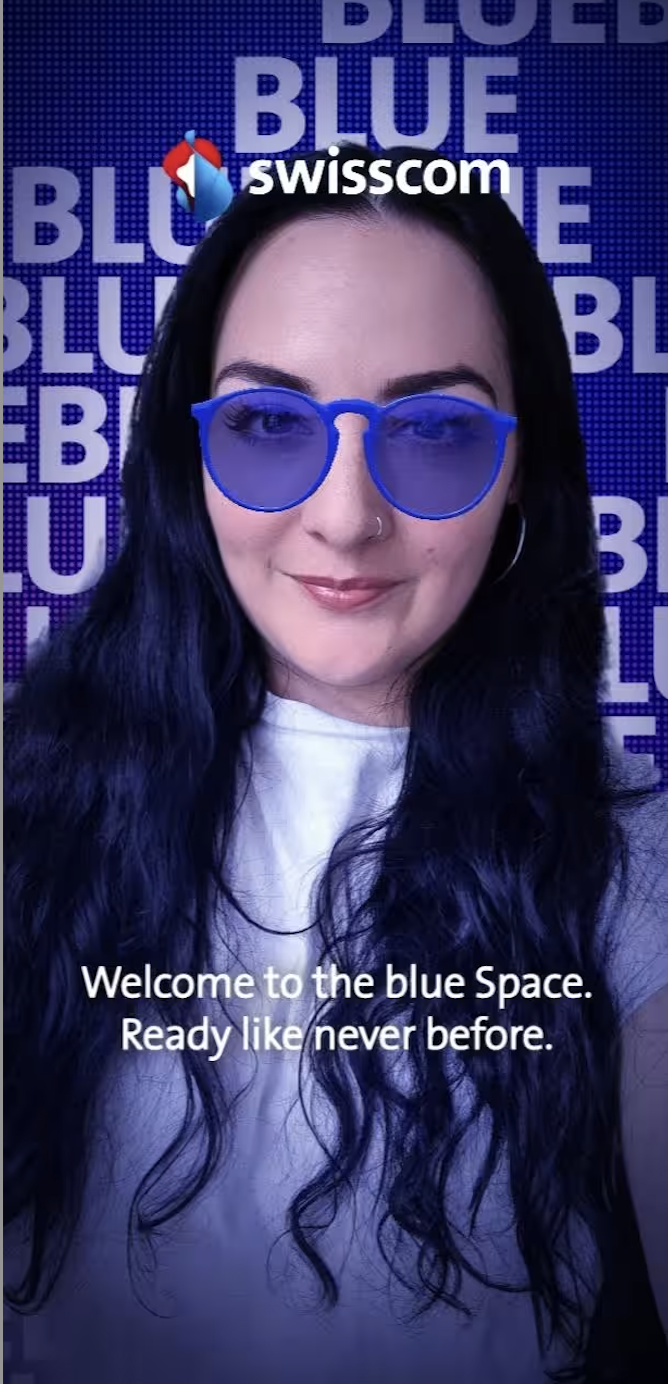
Similarly, theme-based party organizer Partyvorous ran an Instagram Story ad about a timely event they’re running.

Social media advertising is an excellent way to boost awareness about a particular event or launch.
But you can also incorporate social media advertising into your social media marketing strategy regularly when you have the budget and resources for it. For example, you can allocate $500 monthly to run ads on your desired social platforms.
However, you should have a clear business goal attached to your social media advertising efforts. Let’s say you aim to increase brand awareness via social media ads. This objective will dictate what types of ads you run, what copywriting you use for your ad copy, and more. Clarity on your goals with social media advertising ensures you get a positive return on investment (ROI) for the money you put in.
⚡ Remember: Social media advertising supplements organic social media marketing (it doesn’t replace it). Suppose your business goals are to boost sales. In that case, your marketing strategy for both organic and paid efforts should be to promote discounts, discuss the benefits of your products, and redirect people to your store.
The 5 components of social media advertising
Different social networks have different components in their ads manager. However, a few elements remain similar across all social channels. Here are five of them and what they mean.
1. Campaign objectives
Campaign objectives are the reason you’re running an ad campaign. There are three primary types of campaign objectives:
- Awareness is boosting the reach of your brand. Choose this objective if your goal is to let more and more of your target audience know that your brand exists and solves their problem.
- Engagement is for increasing the interaction of your target customers with your company. If you want them to visit your website, check out your social media page, or watch a video/read an article in full, choose the engagement objective.
- Conversion is an objective for lead generation. It’s the right choice for announcing a sale, encouraging people to sign up for your newsletter, or even attracting candidates for a job role at your company.
Different social media platforms call them different names, but usually, they fall under the category of awareness, engagement, or conversions.
In Facebook advertising, for instance, the three large options are further divided into six categories:
- Awareness
- Traffic
- Engagement
- Leads
- App promotion
- Sales
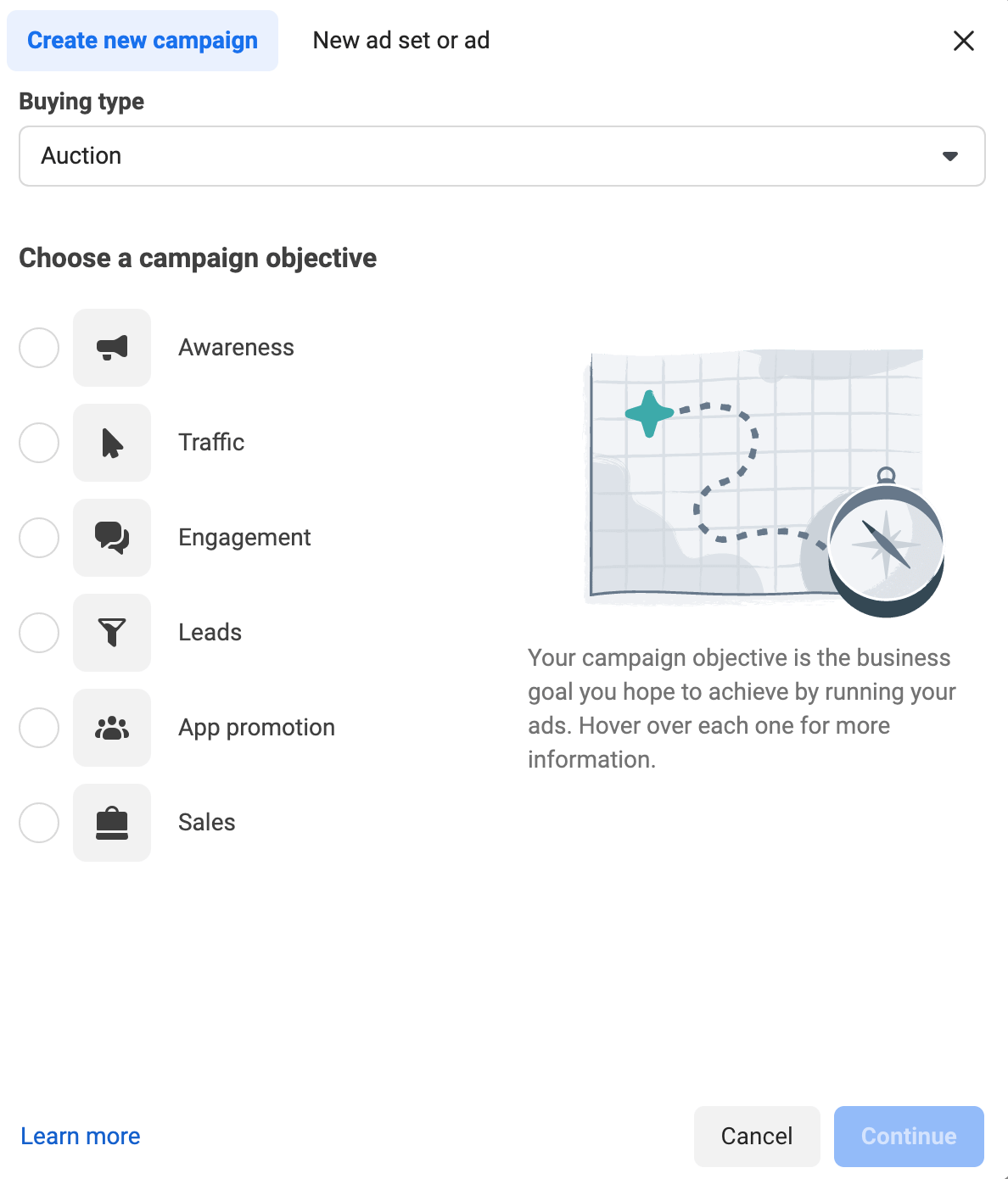
In LinkedIn advertising, the same three objectives are listed with sub-options:
- Awareness
- Consideration — website visits, engagement, video views
- Conversions — lead generation, website conversions, job applicants
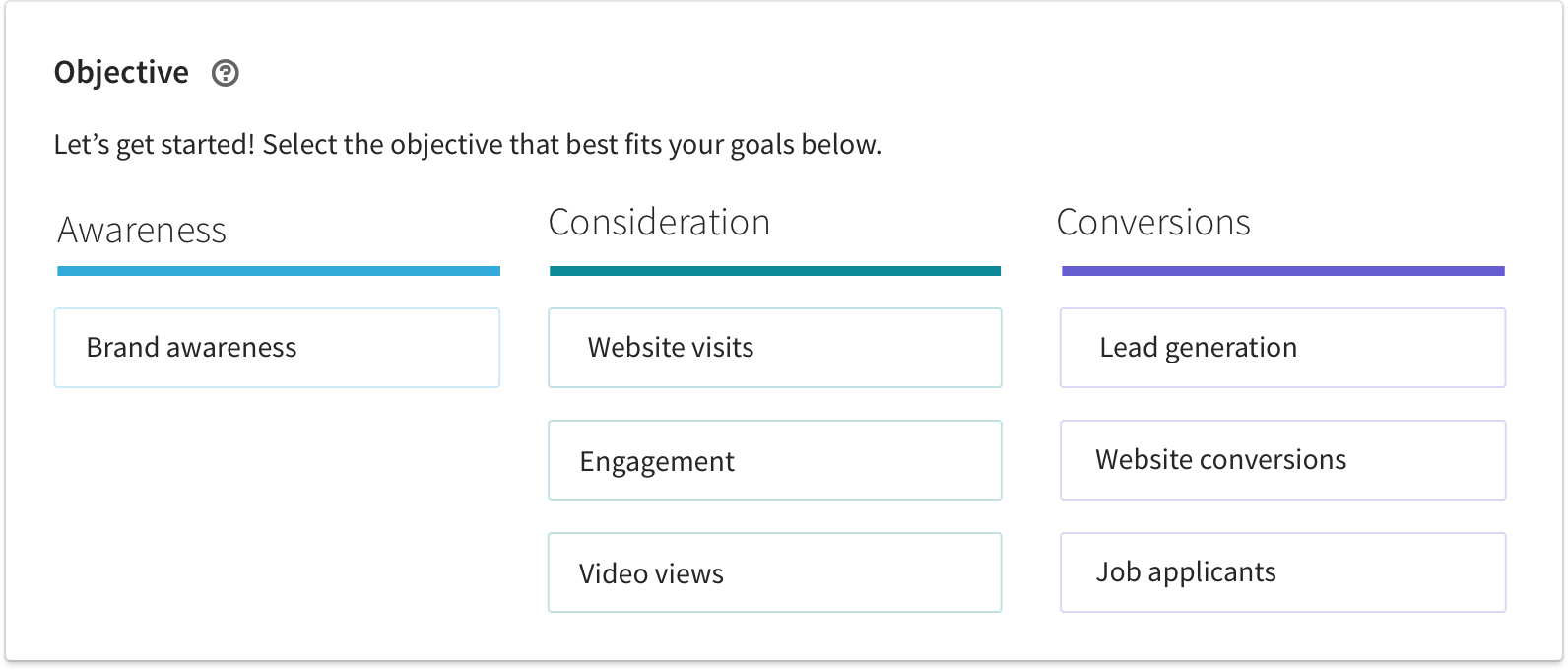
2. Target audience
Audience targeting is the primary advantage of running social media ads. You reach your ideal persona of customers directly without the hit-and-miss of the algorithm. All social media channels will ask you to choose who your target audience is for every social media advertising campaign. For example, X (formerly Twitter) advertising has targeting options like location, gender, age, language, device, conversation, and more.

The options look similar in Instagram advertising (within Meta Ads Manager).
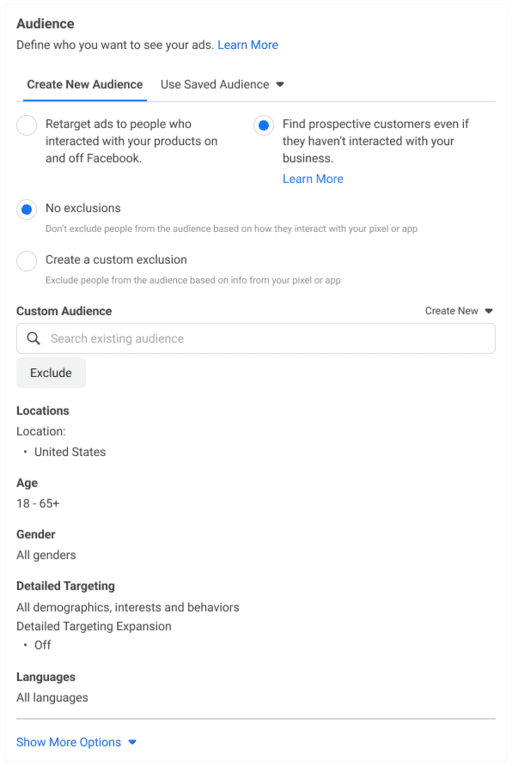
Audience targeting is crucial because you don’t want to waste your money reaching people who aren’t keen to buy from you. If you don’t already have an established potential customer, examine:
- The insights from your organic content on socials
- The personas of your existing customers
For example, if you notice that most people who engage with your post (and buy) are women between the ages of 18 and 35 from the U.S., that is your ideal demographic for audience targeting in social media ads.
You also need to verify if your target users hang around on your chosen social media platform. For example, GenZ’s favorite social media channels include Instagram and TikTok, while millennials prefer Facebook, according to GWI.

Ensuring the social channel where you’re running ads has a good number of active users in your target demographics is an easy way to boost your ROI. For example, if your ideal customer is in the Baby Boomer generation, your best bet is running ads on Facebook, where they’re the most active (compared to TikTok).
⚠️ Remember: Be aware of retargeting in your ads. Retargeting is when a customer sees your ad in their social media feed again. It can be helpful, but if done too much, your consumers can get annoyed. It’s a fine line to tread. Set frequency limits on how often social media users will see your ad.
3. Ad creative
Ad creative includes three things:
1. The visual element of an ad — image, video, or GIF
2. The copy of an ad — the headline, description, and caption
3. The call to action — the offer of the social media ad and how it’s framed
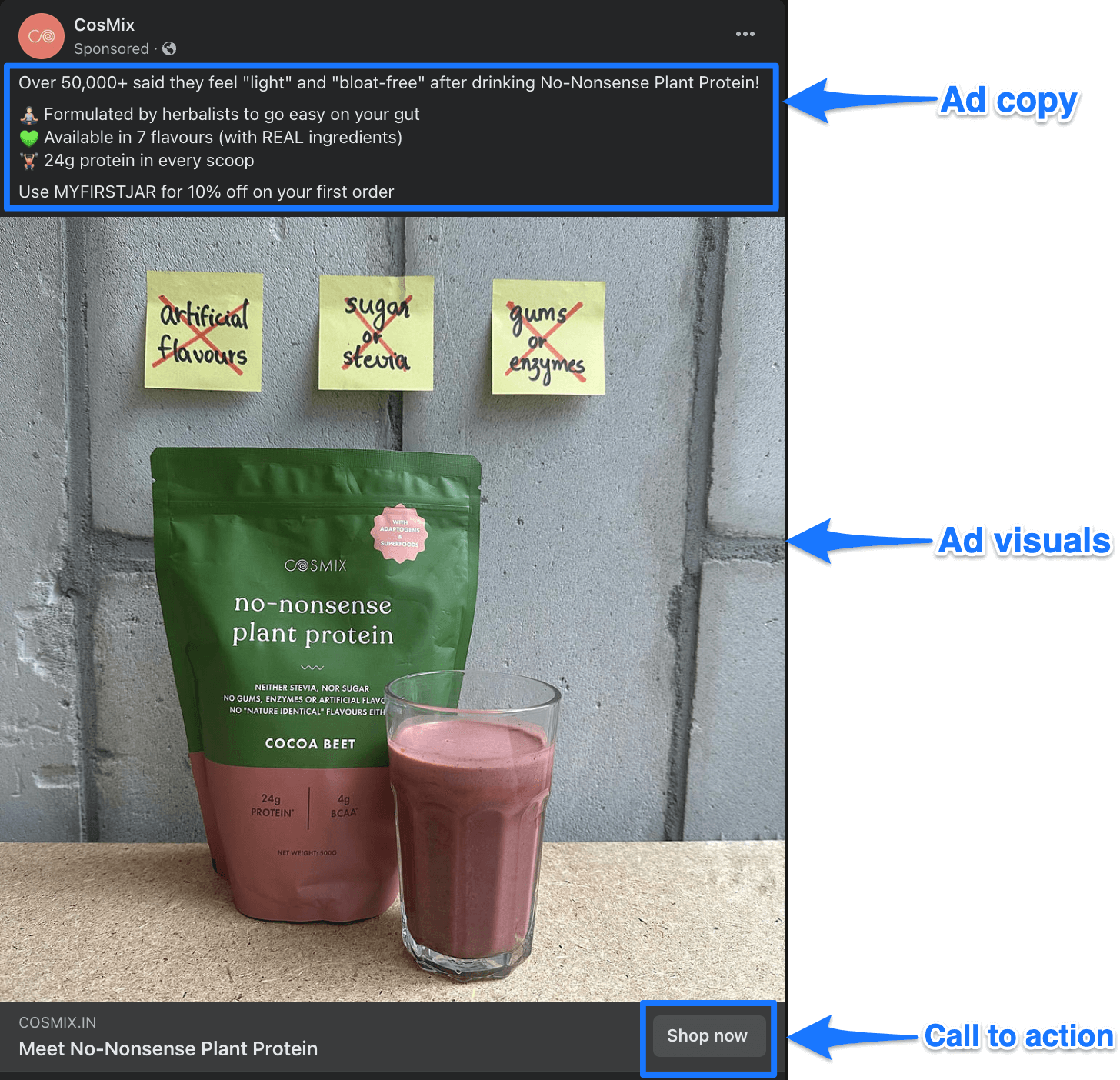
Ad creative can make or break your social media advertising campaign. The right messaging and scroll-stopping visuals will give you the most ROI. In the above example, I’d recommend using the code somewhere in the image and description so it’s clearly visible (rather than getting buried in the caption).
You might need to test various visual media, messaging, and offers before you find the one that gives you the best results. Leave some room for experimentation and A/B testing in this department.
Many social media channels — like Facebook and Instagram — also allow you to outsource the messaging placements to the platform. This means Meta will test which visual media and messaging is performing the best for you in what post type (in-feed, Stories, etc.) and double down on it.
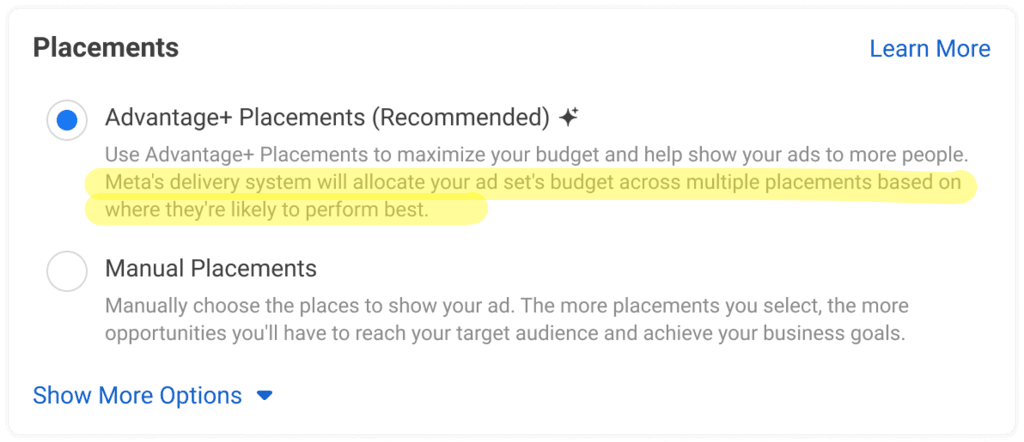
4. Ad budget
Although every social media platform will ask you to dedicate money to running ads, there’s no one golden number that you should invest in social media ads. (Annoying, I know.) The right ad budget depends on your marketing budget, the social platform you’re using to run ads, the industry, and the space you have to experiment.
Cost per click (CPC) and cost per impression (CPM) differ for every social media platform.
- CPC is the cost you pay for your target audience to click on your ad. It’s calculated by dividing the total ad cost by the total number of clicks. The cost of running Facebook ads, for example, is between $0.26 and $0.50. This means a single click on your Facebook ad will cost you $0.26 (minimum).
- CPM is the cost you pay for your target demographics to look at your ad. An “impression” is when your ad appears on someone’s social media feed while they scroll (whether or not your ad stops the scroll is a different story). It’s calculated by dividing the total ad spend by the number of ad impressions and multiplying that number by 1,000. The cost per a thousand impressions for Facebook is between $1.01 and $3.00.
WebFX has made a handy graphic detailing how much social media advertising costs in 2024 for all popular social media platforms like Facebook, Instagram, YouTube, LinkedIn, Pinterest, and Twitter. For TikTok, the average CPM is $10, and the minimum cost is $0.50.

As is evident from the numbers above, TikTok might require more ad spend than Facebook to get similar results. So if your target audience is on TikTok, you’d have to invest more money in running the same number of ads. Facebook might be comparatively more cost-effective. If you are a small business, knowing each platform’s cost is helpful to make the most of every penny.
⚡ Remember: These costs are average numbers. Your actual ad price may differ depending on your budget, demographics, and country.
Whichever social channels you run your ads on, you must leave some wiggle room for mistakes, A/B testing, and experimentation. Your first ad might not have the best ROI, but you have to keep at it and try various ad creatives, copy, and offers to see what performs the best for you.
5. Ad analytics
All social networks will give you the performance details of your social media advertising campaign. The basic metrics include reach, click-through rate, impressions, and cost per click. This is what the dashboard looks like for Pinterest ads.

But most social channels go beyond this by integrating your website’s API to make performance evaluation even more accurate. LinkedIn ads, for instance, allow you to add its Insight Tag to your website to capture visits and clicks on call-to-action buttons automatically.
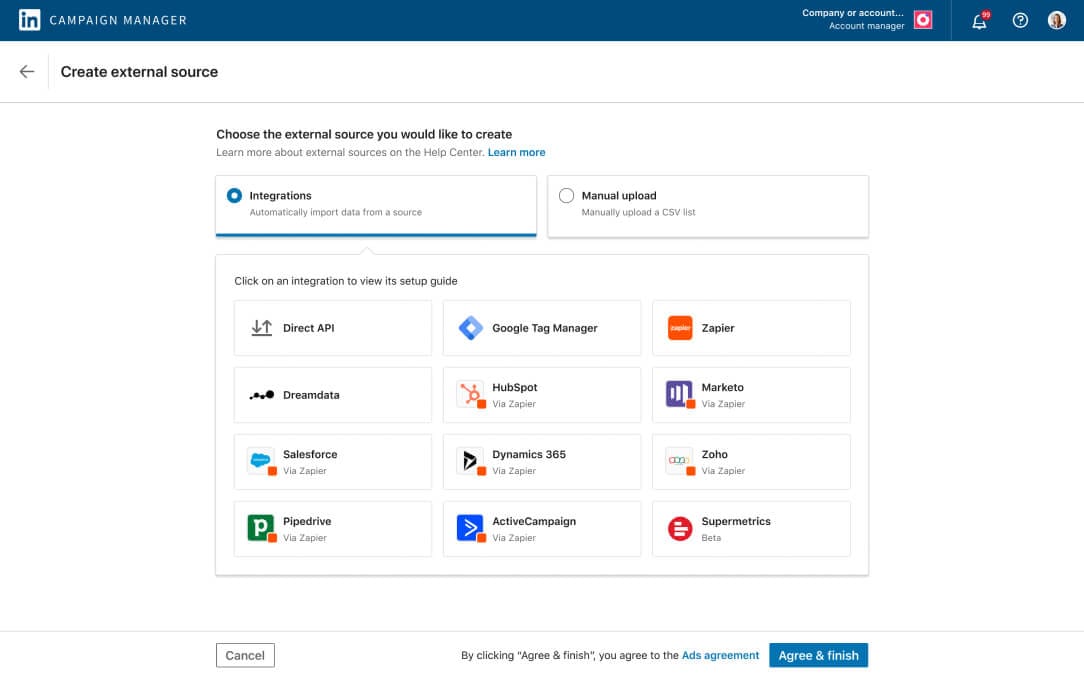
This makes the process of tracking conversions easier and more precise. It also lets you build custom reports to share with stakeholders.
Ultimately, your ad analytics help you determine what’s working with your marketing campaigns and what isn’t. You can use tangible data to modify your advertising strategy and make it more profitable.
7 types of social media ads
The various social media platforms support different ad formats. Facebook, Instagram, and Snapchat have Story ads, for instance, while LinkedIn and X (formerly Twitter) have text ads. While there are certainly some differences, there’s a large common ground in the ad formats across all social networks. Here are the seven most common types of ads across all platforms.
1. Image ads
Image ads are the most common type of ads available on every social media platform you can think of. The telltale sign of an image ad is in the name: The visual element is a single image. Here’s an example of a LinkedIn ad from KlientBoost.
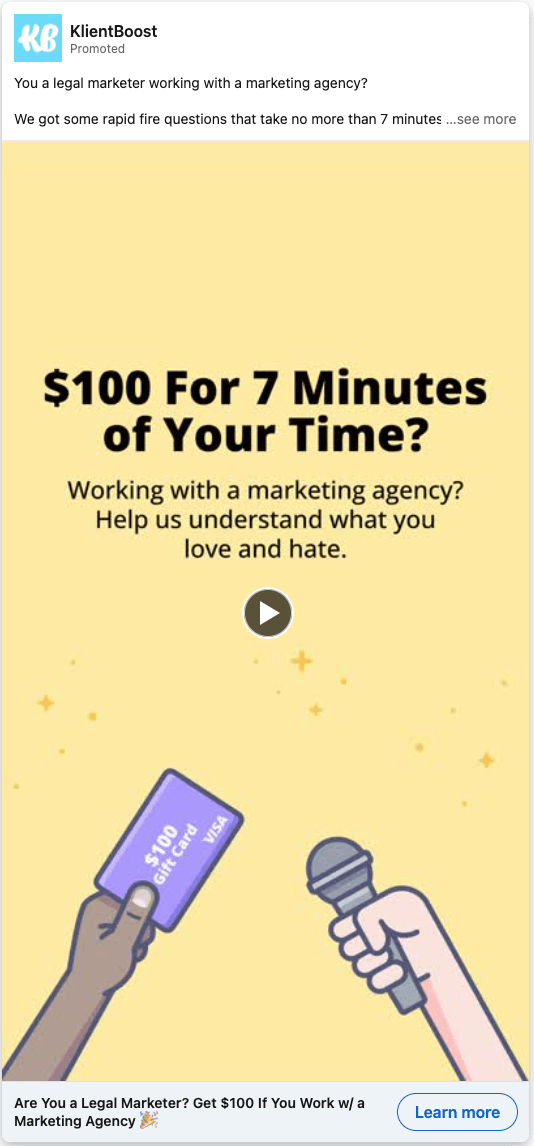
The critical thing in image ads is to keep the visuals clean and scroll-stopping. If you’re sharing a promo code or highlighting a discount, the image should say that, too (along with the caption).
2. Video ads
Video ads are available on all social media platforms, including Instagram, TikTok, Facebook, Pinterest, YouTube, LinkedIn, and X (formerly Twitter). It’s unsurprising because video content is generally more interactive than any other visual elements and gives a better understanding of the product or service in action.
This TikTok ad by REFORM Skincare is a great example of what an excellent video ad looks like.
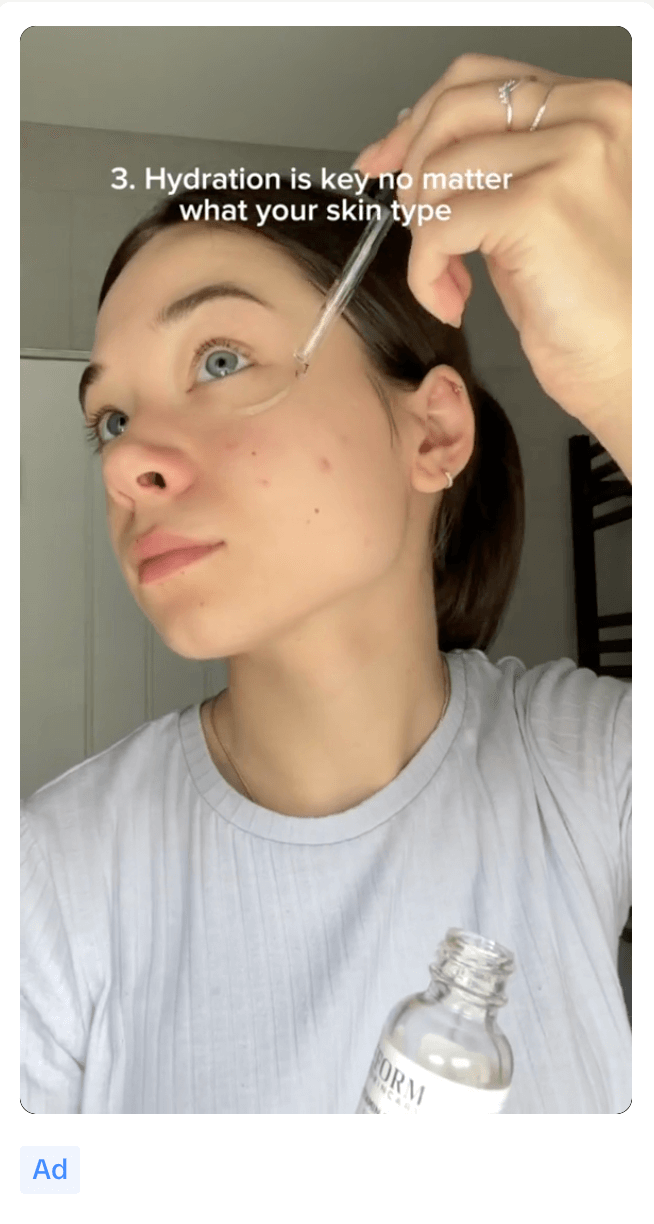
Remember that “video ads” is a large umbrella term, and every social media platform has various subtypes of video ads. For example, on Instagram, you have Instagram Reel Ads for video ads — like Sky Goodies has.
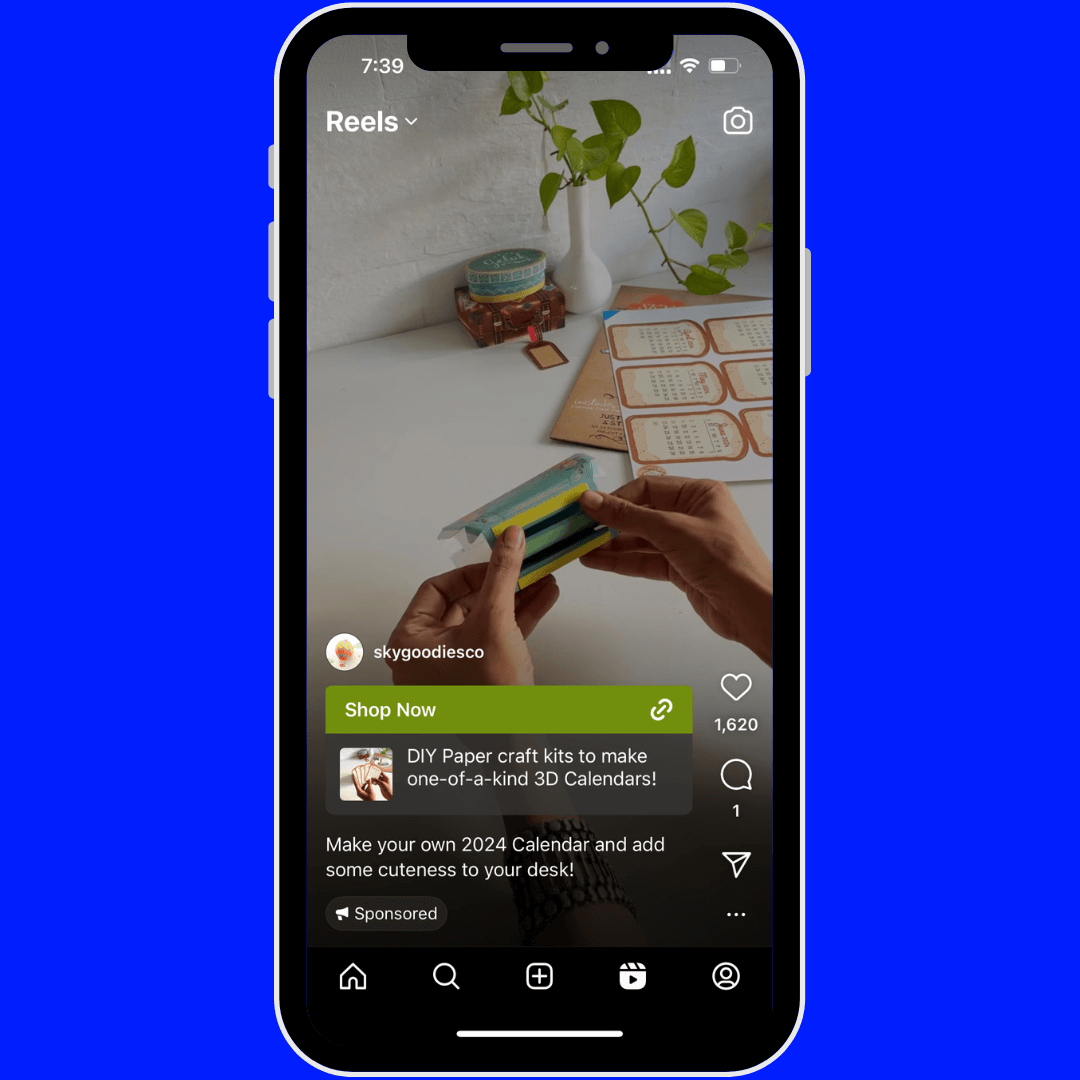
But on a platform like YouTube, video ads come in many forms:
- There are ads that come mid-stream for users (when they don’t have a premium subscription and/or don’t use an ad blocker)
- There are unskippable ads at the beginning or end of the video
- There are ads in the recommendations section

For creating top-performing video ads (on any platform), it’s best to test your influencer or user-generated content, as it often has real people using your product live. It also increases the relatability and interactiveness of your ad to have “people like me” for your target audience in the ads.
3. Carousel ads
A carousel post is where you display multiple images or videos on a sliding scale. You just have to swipe left to keep seeing more posts. Carousel ads are supported by Facebook, Instagram, LinkedIn, and X (formerly Twitter). Here’s an example of a carousel ad by Ulta Beauty on Facebook and Instagram.
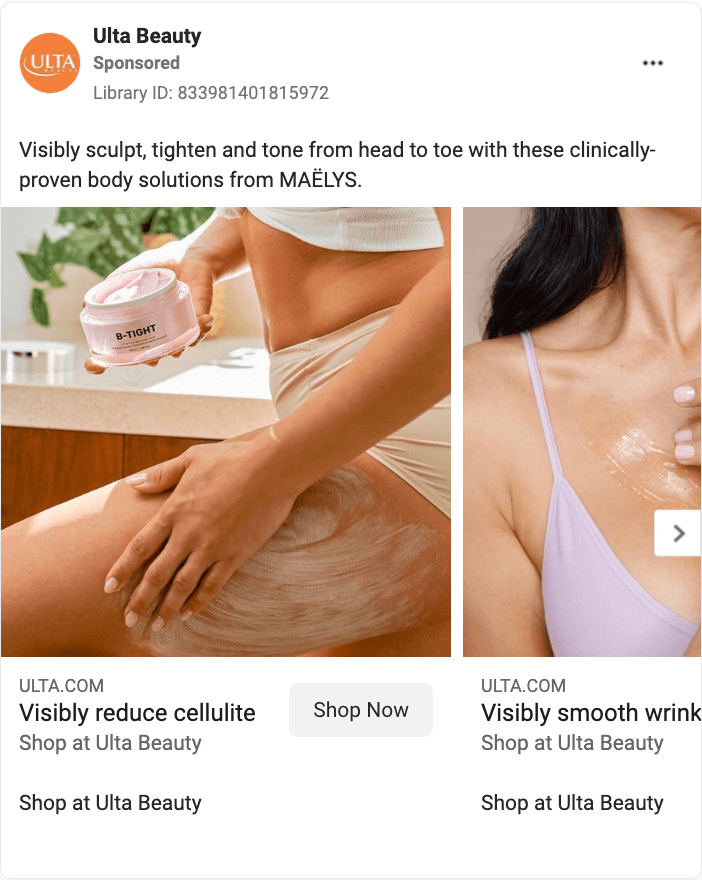
Carousel ads are great for highlighting the various features of your product, mixing multiple visual elements like image & video, telling a story, or even giving a product tour.
4. Collection ads
A slight variation to the carousel ads is the “Collection” ad available on Snapchat, Facebook, Instagram, TikTok, Pinterest, and X (formerly Twitter). This ad by Drinkfinity is an excellent example of a collection ad.
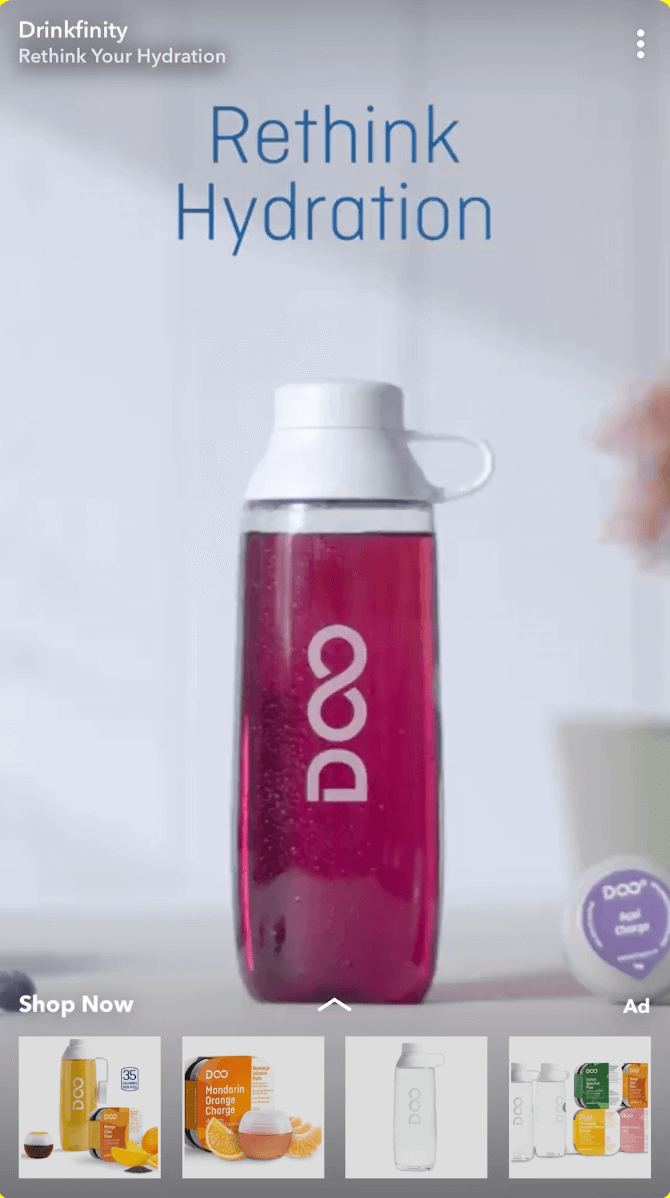
The difference is you see one large image and several small images at the bottom. Collection ads also allow social media users to purchase your products directly. It’s best for ads aiming for direct conversions.
5. Story ads
Stories is a post type available on Facebook, Instagram, and Snapchat. These types of posts last for 24 hours only — making users much more likely to see them with a sense of urgency.
Your Story ad appears when people are sweeping through the Stories of the people they follow. Purplup runs great Instagram Story ads.
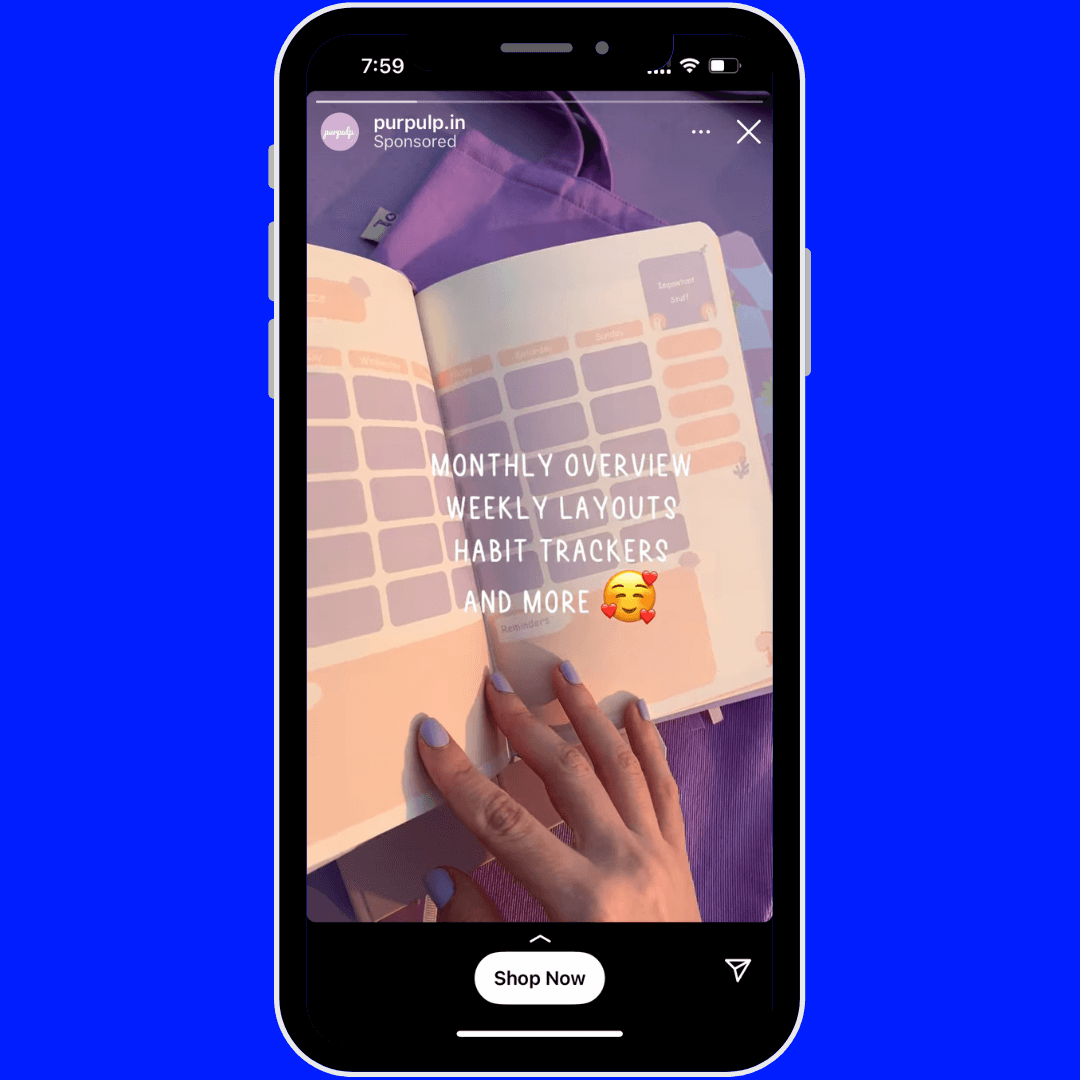
The media format inside a Story ad can be image or video. Videos are much more interactive, making it more likely that people won’t skip through your ad. In general, carousel ads are excellent for timely ads like a sale or event promotion.
6. Messaging ads
Messaging ads are the ad types available on Facebook and LinkedIn. You can target your audience and send a message to their inbox directly. Your message is marked as an “ad” on Facebook Messenger and “Sponsored” on LinkedIn. It’s like delivering your ad directly to your potential customer’s inbox. The below ad by food company Cosmix shows what a Messenger ad looks like:

Messaging ads are a bit aggressive because they appear directly in your target audience’s inbox — but that also might make it more likely for them to click on the ad. If you want something a bit more subtle, Instagram and Facebook both have options of initiating a chat on Direct Messages when someone interacts with your ad instead of displaying ads in your audience’s inbox. Below is an example from dessert company La Bake Amore of what this type of ad might look like in action:

It’s an Instagram Story ad with a “Send us a message” call to action and various prompts for people interacting with your ad to begin a conversation.
7: Dynamic ads
Dynamic ads are interactive ads where your audience can fill out a survey or enter their contact information when they interact with the ad. These ads are available on Facebook, Instagram, LinkedIn, Snapchat, TikTok, and X (formerly Twitter). The fitness company Academy of Strength runs these ads:
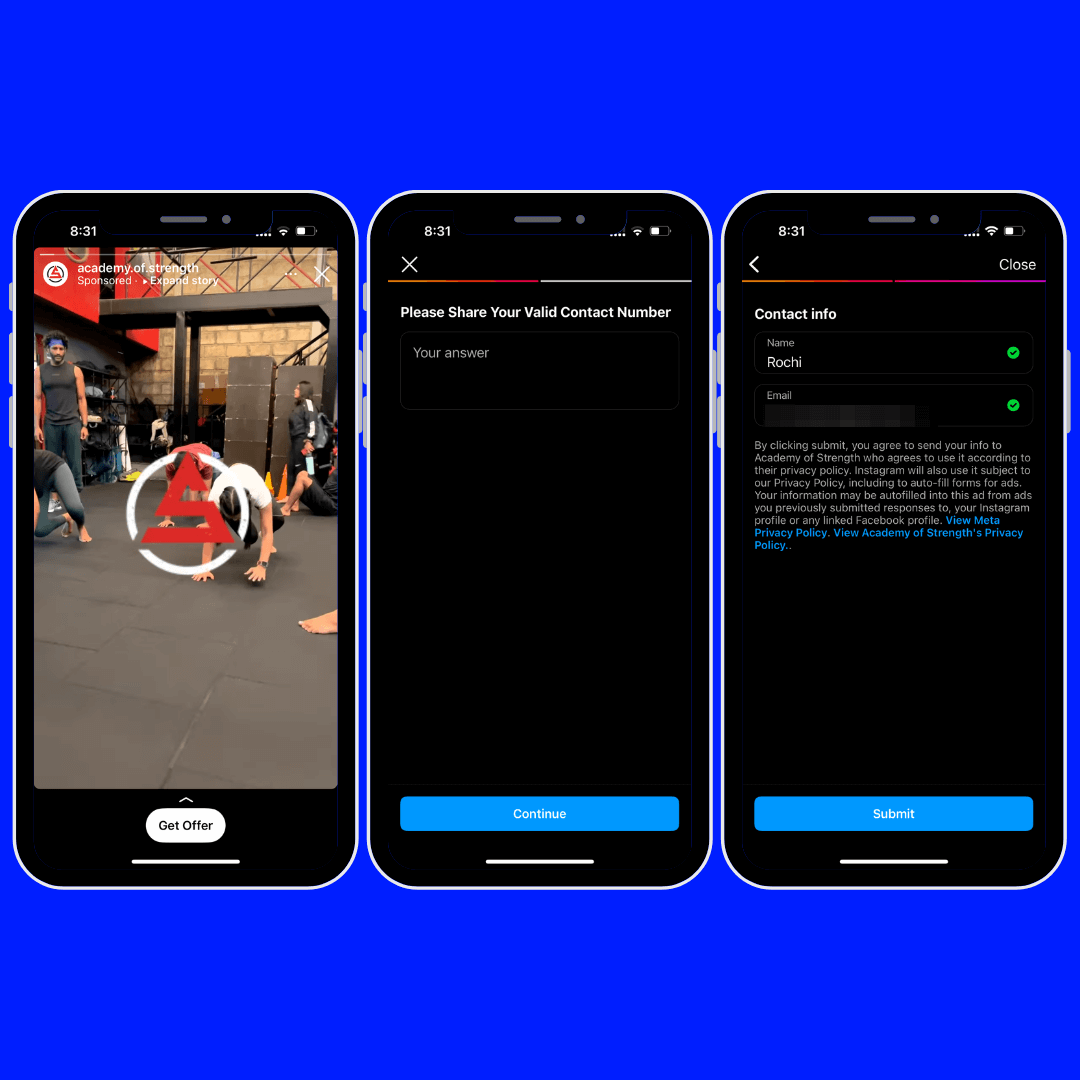
These ads are great for running surveys, getting your target audience to sign up for something, and making more interactive ads in general. You can also use these types of ads to run mini-games.
What makes social media ads click (on all social media platforms)
Learning the nooks and crannies of social media advertising isn’t just a technical affair. You can know the types of ads, nail the components, and still fall short of your expectations. But it doesn’t have to be that way. If you’re a beginner, here are some best practices to follow while running social media ads:
1. Match the vibe of the social media platform
People come to different social networks for various reasons. Whenever you create an ad, match the purpose to the social media platform. For example, Instagram is more suited for eye candy content, TikTok to explore new products & see funny videos, and LinkedIn is best for discovering career-adjacent opportunities. Don’t run the same ad on every social media platform. Repurpose content and adapt it to fit the style of various social networks.
Along with the platform, you also have to match your demographics’ expectations. GenZ and Millennials expect social media ads to be funny and trending, for instance, according to GWI.

2. A/B testing and experimentation are your best friends
Success follows experimentation is a well-known secret for creating effective social media ads. Explore various ad formats, copywriting techniques, and creatives to see what performs the best and optimize accordingly. Use your ad analytics to determine what’s clicking with your audience and double down on it.
Most social networks allow you to create multiple versions of the same ad. Use them! Even slight tweaks can make a big difference when it comes to social media advertising.
3. Put your product and offer front and center
Don’t bury the lede. People are expecting to learn more about your product or service when they see a social media ad. So talk about how you solve their problems, sure, but don’t forget to highlight all the amazing features of your product and the offer attached to the ad.
Fit social media advertising into your social strategy
In the realm of digital marketing, social media advertising is never in a silo. Organic and paid marketing go hand-in-hand in forming a cohesive social media strategy. If you see an organic post performing well, test it as an ad and see how it performs. What performs well organically is more likely to perform well in paid efforts, too.
Social media costs money, and your organic marketing ensures you spend it on the right kind of posts and messaging. See which organic posts hit and flop and use those insights to boost your ad campaigns. But for enough data on your organic posts, you need backend detailed insights from a third-party tool and a consistent posting schedule. Try Buffer for free to do all that (and more!). Sign up and hit the ground running today.










